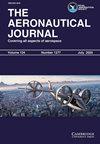Viscous contribution to the high Mach number damping in pitch of blunt slender cones at small angles of attack
IF 1.6
4区 工程技术
Q2 ENGINEERING, AEROSPACE
引用次数: 2
Abstract
Summary The dynamic stability derivatives of blunt cones for small variations in angles of attack have been previously derived by the current author. However, no account of the unsteady nature of the boundary layer was made in that work. In this paper closed form expressions for the increment in dynamic stability due to the presence of the boundary layer are derived by considering the pressure distribution perturbations as the boundary layer continuously adjusts to the enclosed oscillating body. The theory provides a first hand estimate of the complete pitch derivative damping without having to resort to more rigorous and expensive computational methods. Calculations performed at Mach numbers of 7 to 10 with axis positions ranging from 0·5 to 0·7 of the chord length for cones of semi-angle 10° and 20°, indicate that the effect of boundary layer is to slightly reduce the magnitude of the inviscid damping derivative. For blunt cones at angles of attack less than 5°, this was in good agreement with the limited experimental data available.钝细长锥在小迎角下高马赫数阻尼的粘性贡献
钝锥在攻角变化小的情况下的动态稳定性导数已经由目前的作者推导出来。然而,在这项工作中没有考虑到边界层的非定常性质。本文考虑了边界层不断向封闭振荡体调整时的压力分布扰动,导出了边界层存在引起的动力稳定性增量的封闭表达式。该理论提供了完整的音高导数阻尼的第一手估计,而不必诉诸更严格和昂贵的计算方法。对半角为10°和20°的锥体,在马赫数为7 ~ 10、轴位为弦长0.5 ~ 0.7的情况下进行的计算表明,边界层的作用是略微降低无粘阻尼导数的大小。对于迎角小于5°的钝锥,这与有限的实验数据很好地吻合。
本文章由计算机程序翻译,如有差异,请以英文原文为准。
求助全文
约1分钟内获得全文
求助全文
来源期刊

Aeronautical Journal
工程技术-工程:宇航
CiteScore
3.70
自引率
14.30%
发文量
86
审稿时长
6-12 weeks
期刊介绍:
The Aeronautical Journal contains original papers on all aspects of research, design and development, construction and operation of aircraft and space vehicles. Papers are therefore solicited on all aspects of research, design and development, construction and operation of aircraft and space vehicles. Papers are also welcomed which review, comprehensively, the results of recent research developments in any of the above topics.
 求助内容:
求助内容: 应助结果提醒方式:
应助结果提醒方式:


